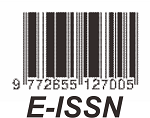ANALISIS PENGARUH KETIDAKHOMOGENAN FANTOM TERHADAP DISTRIBUSI DOSIS ELEKTRON MENGGUNAKAN SIMULASI MONTE CARLO
DOI:
https://doi.org/10.46918/karst.v7i2.2241Keywords:
electron beam;inhomogeneous phantom;Monte CarloAbstract
The usage of homogeneous phantom in the calibration of LINAC is the standard in radiotherapy. However, a homogeneous phantom cannot accurately represent the complexity of the human body. This study was conducted to perform a Monte Carlo simulation of electron beam irradiation on an inhomogeneous phantom and then compare the resulting dose distribution values, in the form of PDD, with the PDD values obtained from a homogeneous phantom. Irradiation was performed with a 6.6 MeV electron beam on an inhomogeneous phantom resembling the human body. It was discovered that there is a significant difference between the R100 and R50 values of the inhomogeneous phantom in comparison to the homogeneous water phantom. The R100 value of the inhomogeneous value differs by 53.33% compared to the homogeneous phantom, while the R50 value differs by 41.07%. This indicates the influence of electron beam interaction with the inhomogeneous phantom on the resulting dose distribution. In the PDD curve, it is observed that the electron beam passing through the inhomogeneous medium experiences a greater loss of kinetic energy compared to the homogeneous medium. It was found that there’ a significant difference between the PDD values generated in the inhomogeneous phantom compared to the homogeneous phantom.
References
Berger, M., Coursey, J., Zucker, M., & Chang, J. (2017, Juli). Stopping-Power & Range Tables for Electrons, Protons, and Helium Ions. Dipetik Maret 1, 2024, dari NIST Physical Measurement Laboratory: https://www.nist.gov/pml/stopping-power-range-tables-electrons-protons-and-helium-ions
Chang, W., Koba, Y., Furuta, T., Yonai, S., Hashimoto, S., Matsumoto, S., & Sato, T. (2021). Technical Note: validation of a material assignment method for a retrospective study of carbon-ion radiotherapy using Monte Carlo simulation. Journal of Radiation Research, 62(5), 846-855.
Cheraghian, M., Pourfallah, T., Sabouri-Dodaran, A. A., & Gholami, M. (2022). Calculation of photoneutron contamination of Varian linac with new target in tissue equivalent phantom using Monte Carlo simulation. Journal of Basic Research in Medical Sciences, 9(3), 31-41.
Chetty, I. J., Curran, B., Cygler, J. E., DeMarco, J. J., Ezzell, G., Faddegon, B. A., . . . Siebers, J. V. (2007). Report of the AAPM Task Group No. 105: Issues associated with clinical implementation of Monte Carlo-based photon and electron external beam treatment planning. Medical Physics, 34(12).
Evans, M. D. (2005). Computerized Treatment Planning Systems for External Photon Beam Radiotherapy. Dalam E. B. Podgorsak, Radiation Oncology Physics: A Handbook for Teachers and Students (hal. 387-406). Wina: IAEA.
Fielding, A. L. (2023). Monte-Carlo techniques for radiotherapy applications I: introduction and overview of different Monte Carlo codes. Journal of Radiotherapy in Practice, 22, 1-6.
Furuta, T., & Sato, T. (2021). Medical application of particle and heavy ion transport code system PHITS. Radiological Physics and Technology, 14(3), 215-225.
Ivana, H. (2023). Analisis Kurva Persentase Dosis Kedalaman dan Profil Dosis Berkas Elektron 8, 12, Dan 15 MEV Menggunakan Simulasi Monte Carlo. Matana University, Program Studi Fisika. Tangerang: Matana University. Diambil kembali dari http://repository.matanauniversity.ac.id:8080/xmlui/123456789/1176
Jang, K. W., Lee, M., Lim, H., Kang, S. K., Lee, S. J., Kim, S. H., . . . Jeong, D. H. (2020). Monte Carlo Simulation of an Electron Irradiation Device for Medical Application of an Electron Linear Accelerator. Journal of the Korean Physical Society, 76(7), 588-591.
Khan, F. M., & Gibbons, J. P. (2014). Khan's The Physics of Radiation Therapy (5th ed.). Philadelphia: Lippincott Williams & Wilkins.
Kholghi, N., Pouladian, M., & Monfared, A. S. (2022). Evaluating the accuracy of electron pencil beam dosimetry based on Monte Carlo simulations using homogeneous and heterogeneous phantoms. Informatics in Medicine Unlocked, 31.
Manik, J. T., Okselia, A., Gaspersz, D. G., & Haryanto, F. (2023, Desember). Validation of Varian Clinac iX Model on 6 MV Photon Beam Using Fast Monte Carlo Simulation. Jurnal Ilmiah Teknik Elektro Komputer dan Informatika, 9(4), 951-958.
Onizuka, R., Araki, F., Ohno, T., Nakaguchi, Y., Kai, Y., Tomiyama, Y., & Hioki, K. (2016). Accuracy of dose calculation algorithms for virtual heterogeneous phantoms and intensitymodulated radiation therapy in the head and neck. Radiol Phys Technol., 9(1), 77-87.
Podgorsak, E. B. (2005). Basic Radiation Physics. Dalam E. B. Podgorsak, Radiation Oncology Physics: A Handbook for Teachers and Students (hal. 1-44). Wina: IAEA.
Podgorsak, E. B. (2005). Treatment Machines for External Beam Radiotherapy. Dalam E. Podgorsak, Radiation Oncology Physics: A Handbook for Teachers and Students (hal. 123-160). Wina: IAEA.
Putha, S. K., Lobo, D., Raghavendra, H., Srinvias, C., Banerjee, S., Athiyamaan, M. S., . . . Krishna, A. (2022). Evaluation of Inhomogeneity Correction Performed by Radiotherapy Treatment Planning System. Asian Pacific Journal of Cancer Prevention, 23(12), 4155-4162.
Sato, T., Niita, K., Matsuda, N., Hashimoto, S., Iwamoto, Y., Furuta, T., & Sihver, L. (2014). Overview of particle and heavy ion transport code system PHITS. Annals of Nuclear Energy, 82, 110-111.
Strydom, W., Parker, W., & Olivares, M. (2005). Electron Beams: Physical and Clinical Aspects. Dalam E. B. Podgorsak, Radiation Oncology Physics: A Handbook for Teachers and Students (hal. 273-299). Wina: IAEA.
WHO. (2022, Februari 3). Cancer. Dipetik Januari 22, 2024, dari World Health Organization: https://www.who.int/news-room/fact-sheets/detail/cancer
Zabihzadeh, M., Ghahremani, Z., Hoseini, S. M., Shahbazian, H., & Ghahfarokhi, M. H. (2020). Effect of lung inhomogeneity on dose distribution during radiotherapy of patient with lung cancer. International Journal of Radiation Research, 18(3), 579-586.
Downloads
Published
Issue
Section
License
Karst : Jurnal Pendidikan Fisika dan Terapannya, adalah Jurnal Akses Terbuka (Open Access Journal). Penulis yang menerbitkan artikelnya dalam jurnal ini setuju dengan ketentuan berikut:

This work is licensed under a Creative Commons Attribution-ShareAlike 4.0 International License.
You are free to:
- Share — copy and redistribute the material in any medium or format
- Adapt — remix, transform, and build upon the material for any purpose, even commercially.
- Attribution — You must give appropriate credit, provide a link to the license, and indicate if changes were made. You may do so in any reasonable manner, but not in any way that suggests the licensor endorses you or your use.
- ShareAlike — If you remix, transform, or build upon the material, you must distribute your contributions under the same license as the original.
- No additional restrictions — You may not apply legal terms or technological measures that legally restrict others from doing anything the license permits.








94.jpg)

















